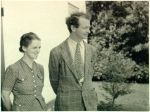
Ways to Approach the Curriculum
Linus Pauling’s career is so long – he first published in the 1920s, and last in the 1990s – that any reading curriculum can only be partial in what it covers. This curriculum can be used as a starting point for particular research interests or it can be used as a basic guide pointing to materials which give a sense of Pauling’s life and work.
Since Pauling’s work and interests ranged across a broad spectrum, it is very helpful to first get a general picture of his life. Some reading in one or more of the full length biographies listed under Topical Readings can be invaluable for an understanding of the progression of Pauling’s work; each of the ones listed has a helpful index, and each sets out biographical information under the index heading "Pauling, Linus." The full length biographies are a good lead to important concepts in Pauling’s scientific thinking, such as hybridization of orbitals, resonance structure, complementarity, stochastic method, electronegativity, and the rules for determining molecular structure which became known as "Pauling’s rules" (See also Thomas Hager’s Force of Nature pg 143). Graduate students may be interested in a concept developed by Pauling’s students called "the Pauling Point."
The edited selections from Linus Pauling provide well-organized and annotated selections from his work under topical headings and are a quick and interesting route to knowledge of his thinking in a particular area. Also available are websites assembled by Special Collections and focusing on specific parts of Pauling's career. These include:
- Linus Pauling and the Nature of the Chemical Bond
- Linus Pauling and the International Peace Movement
- Linus Pauling and the Race for DNA
- It's in the Blood! A Documentary History of Linus Pauling, Hemoglobin, and Sickle Cell Anemia
- The Scientific War Work of Linus C. Pauling
- Linus Pauling and the Structure of Proteins
The main section of the curriculum details Linus Pauling’s scientific work and thinking. In so doing, the curriculum lists major publications and other papers chronologically, with an identification of the research or other life interest to which the item pertains. This section of the curriculum is divided into three parts.
- Early Years: Education, Teaching and the Chemical Bond delves into the early years of Pauling’s career, during which he established his scientific reputation through his work on the chemical bond and his interest in relating chemical information to students in the classroom.
- Middle Years: War Work, Peace Work and Protein Structure covers Pauling’s middle years, including the research that he conducted on behalf of the war effort as well as his later peace activism, continuing interests in structural chemistry, and new scientific investigations including determinations of various protein structures.
- Later Years: Molecular Disease and Orthomolecular Medicine details Pauling’s later years, in particular his work on molecular disease and vitamin therapy, also known as "orthomolecular medicine."
The main section of the curriculum is followed by a brief list of topical readings, which includes materials in the history of science collection and in the general collection at the Valley Library. There is also a brief list of websites on Pauling and related topics, and an appendix of useful information regarding Special Collections.
Readers should be sure to utilize the six-volume published version of the Catalogue of Holdings of the Ava Helen and Linus Pauling Papers the text of which is also available online at http://scarc.library.oregonstate.edu/coll/pauling/index.html. It is essential to look through the catalogue to get a sense of what is available in the collection, and to understand the extent of Pauling’s research notes, personal notes, article writing, correspondence, lectures, love letters, interviews, awards, and occasions photographed. The catalogue is a remarkable achievement, documenting hundreds of thousands of items.
Table of Contents
- Introduction
- Ways to Approach the Curriculum
- Using Archival Materials in Special Collections
- Early Years: Education, Teaching and the Chemical Bond
- Middle Years: War Work, Peace Work and Protein Structure
- Later Years: Molecular Disease and Orthomolecular Medicine
- Topical Readings
- Websites Regarding Linus Pauling
- Appendix: General Guidelines for Use of Special Collections Materials
- Acknowledgements



